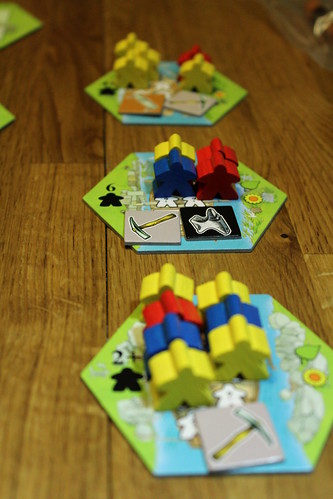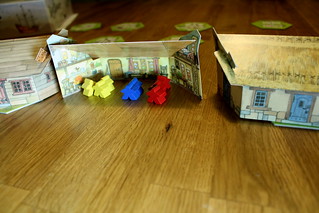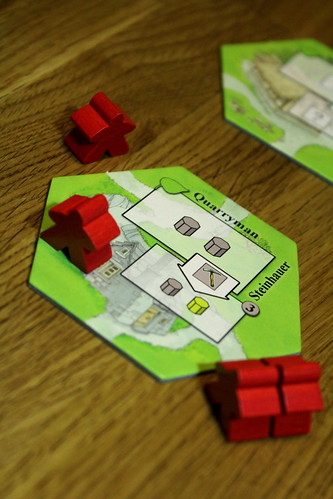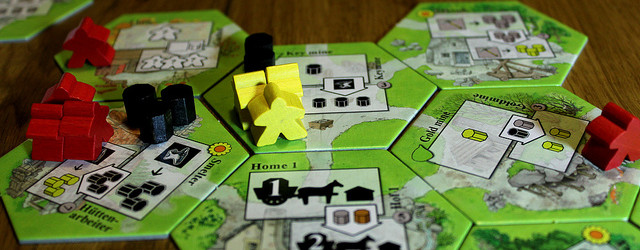| Strategy | Luck |
|---|---|
| Interaction | Components & Design |
| Complexity | Score |
In 1620, the Keyflower with its cargo of pilgrims set out across the Keytlantic Oceanto start a new life in Keymerica, far away from life’s greatest comforts like keyttens, keytar players and alkeymy. But travelling across the oceans was not the biggest challenge these keyple were to face, once they arrived in the new world they had to survive there, and that was no easy job, especially in that first year. This first year is the subject of the newest game in R&D Games Key series, designed by Sebastian Bleasdale and Richard Breese.

You have that one year, split into four seasons, to build a settlement for your keyple, bigger, prettier and especially more conductive to survival than the other players’. To do that, the two key mechanics, if you’ll excuse the pun, are auctioning for and using the actions on the hexagonal village tiles. Every season has its own set of village tiles. How many of them will be available depends on the number of players, but it will never be all of them, you can’t rely on specific tiles being available. To put them into your village, you have to win the auction for those tiles. Auctioning in Keyflower is a clever multi-currency affair where you bid with your keyples (which we would rather call meeples, of course, but we won’t break the linguistic concept of the game like that). The Keyflower keyples come from a very enlightened society that does not discriminate against keyples based on their colour, your starting population is a random mix of blue, red and yellow keyples. Not green ones, though, green keyples are special. To make a bid on a tile, you place any number of keyples of one colour on your side of the tile. The first bid determines the currency for that tile, subsequent bids can only be made in the same currency and, obviously, the highest bidder is awarded the tile at the end of the season. But that’s not all a tile can do, each tile also has an action associated with it – producing wood, stone, iron or gold, producing tools, recruiting new keyples and more. To take that action, you place one to three keyples on the tile, again of the same colour and again more than the previous player used to take this action. The colour is the same used to bid on the tile, but the number of keyples needes is not tied to the auction. Taking actions from tiles that are still in the auction, however, has one downside: your keyples spent on them do not go back to the supply when the season is over but go to the winner of the auction together with the tile, you’ll end up subsidizing your opponents’ villages with these keyples.

Each turn, you make one bid or take one action, until all players pass. Then the season is over and all players add the tiles they won to their village, taking care that the roads on the tiles connect properly. Before the next season, new pilgrims arrive to bolster your workforce. The ships and the count and colour of their passengers are actually visible from the start of the season, giving you a chance to decide which ship you would like to guide to your growing settlement. The order of choice is auctioned through the special turn order tiles, along with the village tiles. You’d do good here to keep count of the keyples arriving at the other villages, knowing which colour of keyples they don’t have is key to thwarting their strategy for the next season. If you’ll excuse the pun again.
The other three seasons go pretty much like spring did, but with more options. The actions on tiles bought in earlier seasons remain available even if they are in another players village. You place keyples just the same and they still fix the colour useable on that tile, so you can lock someone out from using a tile in his own village – if you remember what keyples he has. An especially nasty way to lock players out of their actions are the green keyples that you can only get using the actions on very few specific tiles. Place one of these to take an action and it gets very hard for the other players to take it again. Another new option in seasons two to four is upgrading tiles. Every village tile can be upgraded once by taking an upgrade action – available on tiles like any other action, including your Home tile – and having the right resources available. Those resources have to be available on the tile you wish to upgrade, you have to use your road network to get them there – an important consideration in your city planning. Upgraded tiles may produce more resources, have a lower price for taking their action or simply be worth more victory points. As long as you can afford to, there’s rarely a reason not to upgrade as many tiles as you can.
When you read the rules – or for that matter, this review – Keyflower sounds like a collection of pretty cool mechanics that were tossed together in a salad shaker for new games. It’s hard to convey how intricately all these mechanics mesh together and create a game that is whole and working, with no disconnect between the moving parts. This gives the players many different strategies to explore and, together with the different tiles available in every game, a huge variety. You might equip your village with many interesting actions for other players and get the keypels they used when the season is over. But those actions aren’t worth a lot of points, so instead you might concentrate on valuable tiles instead, but then you have to bid high on the incoming ships or lack the keyples to play. Getting one of the Summer Ships may give you yet another incentive to adapt your strategy as they allow you to bend one rule of the game to your advantage, be it ignoring the set colour when bidding on a tile, doubling all the resource transports you take or receiving additional keyples when picking an incoming ship.

But to what end? Why do all that? Unsurprisingly, for victory points – whoever has the most when winter is over wins the game. You can collect a whole bunch of them during the game, some tiles are worth points on their own, others award points for having the right kind of resources on them when the game ends. But the biggest boost of points tends to come from the winter tiles. Unlike the other seasons, winter tiles are not entirely unknown before winter starts. Instead, each player received some winter tiles at the start of the game and now makes one or more of them available for the usual auction of tiles. Winter tiles do not have actions on them but scoring rules, and whoever ends up with them in their village gets to use that scoring rule. Points may be gained for every keyple of one colour, for resources, for tools, for green keyple only and so on. Or you simply gain a whooping 12 points for having the Keythedral in your village. Knowing some of those tiles from the start is of course another big influence on your strategy, but also introduces an element of bluffing to Keyflower. After all, when you’ve been piling up keyples behind your keyple house view screen the whole game, don’t expect the other players to let you have the points-for-keyples tile quietly. The other way round, if you can guess what tiles the other players have, building towards that goal and then grabbing it from under their nose in winter is a valid and satisfyingly evil way to win.

Requiring knowledge of the available tiles to play well means, of course, that you have to play a few times before you can do it. Unlike some other games with that drawback, these introductory games are still a lot of fun. You may not get the highest score, but exploring what is there is pretty cool as well. Nevertheless, a player aid listing the available tiles would have been handy. There is at least a complete list in the back of the rulebook, but passing it around for the whole first season for everyone to catch up is not exactly practical. But that is really the only downside to find in Keyflower‘s components, everything that is there is of a good quality, looks great and all the tiles make their actions perfectly obvious with simple icons large enough to see from across the table. Especially with six players, that’s a necessity because Keyflower is not a game for the small table: with six villages growing, six view screen, ten tiles per season available in the market plus four turn order tiles and six ships arriving after this season and all those tiles about Settlers of Catan sized… yeah, be glad for big icons.
Playing Keyflower with five or six players has some significant differences from a smaller game. Large games are more chaotic when everyone competes for the same tiles and it becomes close to impossible to keep track of everyone’s available colours. Small games are much more strategic than that and keeping track what everyone is planning and stockpiling is essential. Paradoxically, smaller games also involve slightly more luck as the chance to see a specific tile you were hoping for decreases. However, it never feels like luck dictates the winner in Keyflower, dealing with not having the tiles you wanted is part of the game and is always possible, you don’t ever get stuck because of a missing tile. And although different, Keyflower is a great game in small and large groups with lots of variety, many decisions to make, many different ways to win and a good time for everyone.












Can’t wait to get this game!